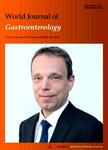Lower esophageal sphincter relaxation is impaired in older patients with dysphagia
Lower esophageal sphincter relaxation is impaired in older patients with dysphagia作者机构:Investigation and Procedures UnitRepatriation General Hospital Department of Gastroenterology and Hepatology Royal Adelaide Hospital Discipline of Medicine University of Adelaide Adelaide 5000 South Australia Australia Department of Medicine Flinders University of South Australia Bedford Park 5042 South Australia Australia
出 版 物:《World Journal of Gastroenterology》 (世界胃肠病学杂志(英文版))
年 卷 期:2011年第17卷第10期
页 面:1326-1331页
核心收录:
学科分类:1002[医学-临床医学] 100201[医学-内科学(含:心血管病、血液病、呼吸系病、消化系病、内分泌与代谢病、肾病、风湿病、传染病)] 10[医学]
主 题:Dysphagia Elderly Esophageal Motility Lower Esophageal Sphincter Aging
摘 要:AIM: To characterize the effects of age on the mechanisms underlying the common condition of esophageal dysphagia in older patients, using detailed manometric analysis. METHODS: A retrospective case-control audit was performed on 19 patients aged ≥ 80 years (mean age 85 ± 0.7 year) who underwent a manometric study for dysphagia (2004-2009). Data were compared with 19 younger dysphagic patients (32 ± 1.7 years). Detailed manometric analysis performed prospectively included basal lower esophageal sphincter pressure (BLESP), pre-swallow and nadir LESP, esophageal body pressures and peristaltic duration, during water swallows (5 mL) in right lateral (RL) and upright (UR) postures and with solids. Data are mean ± SE; a P-value 0.05 was considered significant. RESULTS: Elderly dysphagic patients had higher BLESP than younger patients (23.4 ± 3.8 vs 14.9 ± 1.2 mmHg; P 0.05). Pre-swallow LESP was elevated in the elderly in both postures (RL: 1 and 4 s P = 0.019 and P = 0.05; UR: P 0.05 and P = 0.05) and solids (P 0.01). In older patients, LES nadir pressure was higher with liquids (RL: 2.3 ± 0.6 mmHg vs 0.7 ± 0.6 mmHg, P 0.05; UR: 3.5 ± 0.9 mmHg vs 1.6 ± 0.5 mmHg, P = 0.01) with shorter relaxation after solids (7.9 ± 1.5 s vs 9.7 ± 0.4 s, P = 0.05). No age-related differences were seen in esophageal body pressures or peristalsis duration. CONCLUSION: Basal LES pressure is elevated and swallow-induced relaxation impaired in elderly dysphagic patients. Its contribution to dysphagia and the effects of healthy ageing require further investigation.



